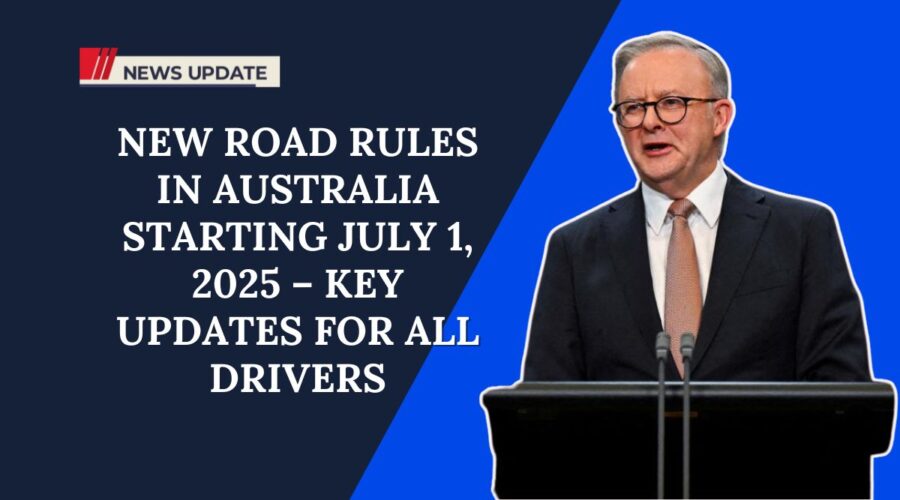New Road Rules in Australia Starting July 1, 2025 – Key Updates for All Drivers
A major shakeup is coming to Australian roads starting July 1, 2025. The federal and state governments are rolling out a series of new road rules designed to enhance road safety, improve traffic flow, and support the transition to more sustainable transport options.
These are not small adjustments — the upcoming changes will directly impact how Australians drive, the penalties they may face for non-compliance, and the rights of other road users such as cyclists and micromobility riders.
Whether you are a daily commuter, truck driver, motorcyclist, or occasional weekend driver, it is critical to understand what is changing and how to stay compliant.
Key Road Rule Changes Coming Into Effect from July 2025
Below is a quick summary of the most important updates that will come into force:
| Change Category | New Law Summary | Applies To |
|---|---|---|
| Speed Limits Near Emergencies | 40 km/h maximum when passing stationary emergency and breakdown vehicles with flashing lights | All drivers |
| Mobile Phone Crackdown | Mandatory use of mounted phone holders, no handling permitted; fines starting at $500 | All drivers |
| Cyclist Safety Rules | Minimum 1 m passing distance below 60 km/h, 1.5 m if above 60 km/h | All vehicle operators |
| Expanded Drug Testing | Roadside drug tests to include prescription medications | All license holders |
| E-Scooter & E-Bike Regulations | 16+ age limit, max 20 km/h on roads, dual brakes, lights required | Personal and shared device users |
| EV Priority Lanes | Designated lanes for electric vehicles in metro areas | Electric vehicle drivers |
| School Zone Extensions | Extended school zone hours and expanded fines for violations | All drivers |
| Passenger Restraint Enforcement | Drivers liable if adult passengers are unrestrained | All drivers |
Why These Changes Matter
The new road rules are being introduced in response to growing safety concerns and Australia’s long-term vision for cleaner and safer transportation.
One of the most important changes is the cyclist passing distance rule, which reflects the increasing number of Australians commuting by bicycle.
To reduce the risk of collisions, drivers will now need to allow a wider berth when overtaking cyclists, particularly at higher speeds.
Another key update is the mobile phone usage crackdown. Authorities have identified distracted driving as a leading cause of road accidents, and the new zero-tolerance approach aims to address this by enforcing stricter fines and using automated AI cameras.
With electric vehicles (EVs) growing in popularity, new priority lanes aim to promote the shift towards cleaner transportation while easing congestion in some of the busiest city centres.
How These Rules Affect Different Drivers
For Urban Drivers
City-based drivers will see the greatest immediate impact from the new laws. The expanded school zones, mobile phone restrictions, and EV priority lanes will require adjustments to daily driving routines. Failure to comply with any of these new rules could result in significant fines and demerit points.
For Regional and Rural Drivers
While EV lanes may not be relevant to rural drivers, updates such as the expanded drug testing, cyclist passing laws, and speed limits near emergency vehicles will apply equally in all areas of Australia.
For Micromobility Users
If you use e-scooters or e-bikes, stricter national standards now apply. You must wear an approved helmet, use front and rear lights, and stay within the designated speed limits. Riding on pedestrian footpaths will largely be prohibited, except where specifically allowed.
Preparing for the New Road Rules
All Australian drivers should begin preparing for these changes now to avoid penalties starting in July. Here are some recommended steps:
- Install a legal phone mount and avoid handling your device while driving.
- Learn the cyclist passing distance requirements and always maintain a safe buffer.
- Be aware of speed limits when passing emergency and breakdown vehicles.
- Consult your doctor about any medications you take that may impact your ability to drive safely.
- If you use an e-scooter or e-bike, ensure it meets the new safety standards and that you understand where it can legally be ridden.
- If driving an electric vehicle, watch for signage indicating EV priority lanes.
What Will Happen If You Break the New Rules?
Penalties will be strictly enforced across all states and territories. Here’s what you can expect:
- Mobile phone offences: Fines starting at $500 and up to 6 demerit points.
- Cyclist passing violations: Fines of up to $450.
- Drug driving: Immediate license suspension, fines, and potential court appearances.
- Speeding past emergency vehicles: Heavy fines and demerit points.
- Unrestrained adult passengers: Drivers will be fined even if the unrestrained passenger is an adult.
Australia’s new road rules from July 1, 2025, represent a significant effort to create safer roads, support environmental goals, and accommodate new transport technologies.
By preparing now and staying informed, drivers can avoid hefty penalties and contribute to a better driving environment for all road users.
FAQs
Do the new mobile phone rules ban all use of the phone while driving?
Yes. You must use a legal mount and only interact with the phone through hands-free functionality. Touching the phone is prohibited.
Are e-scooters still allowed on footpaths?
In most states, e-scooters will be prohibited from riding on footpaths unless specifically permitted by local council regulations.
What happens if I am taking prescription medication?
If your medication affects your ability to drive safely, you could be penalised under expanded roadside drug testing laws. Consult your doctor to understand any potential risks.


Leave a Reply